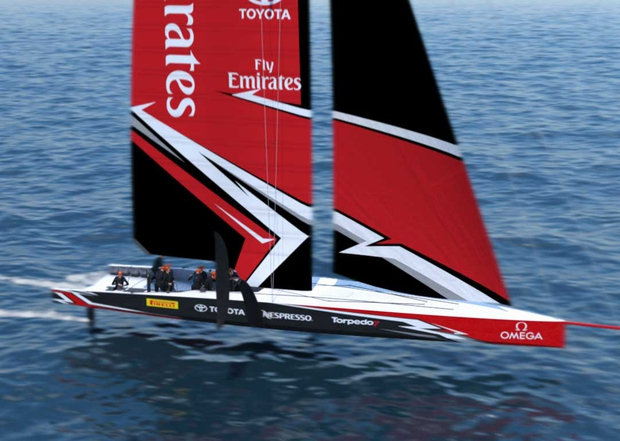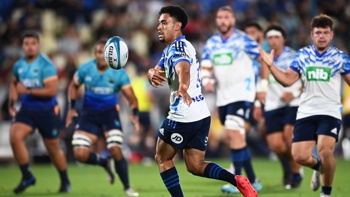Team New Zealand have revealed the new monohull America's Cup yachts will potentially be faster than the catamarans used this year in Bermuda.
Yachts for the Auckland event will be high performance fully foiling monohulls, the result of collaboration between the Emirates Team New Zealand and Luna Rossa design teams.
The goal was to design a class that will be challenging and demanding to sail, rewarding the top level of skill for the crews.
READ MORE: America's Cup base plans face re-think
Team New Zealand CEO Grant Dalton said today they were proud with what the designers had come up with.
VIDEO: The exciting new #americascup class boat is revealed. A full foiling monohull made for match racing #AC75 #ETNZ #ARL @VirtualEyeTV pic.twitter.com/NNGIDvz0FL
— EmiratesTeamNZ (@EmiratesTeamNZ) November 20, 2017
"It has been a phenomenal effort by Dan [TNZ design co-ordinator Dan Bernasconi] and the guys together with Luna Rossa design team. There is a lot of excitement building around the boat in the development and getting to this point.
'Faster than an AC50 both upwind and downwind'
"Our analysis of the performance of the foiling monohulls tells us that once the boat is up and foiling, the boat has the potential to be faster than an AC50 both upwind and downwind.
"Auckland is in for a highly competitive summer of racing in 2020-21."

Team New Zealand believe the yacht could become the future of racing and even cruising monohulls beyond the America's Cup.
'Can right itself in the event of a capsize'
"The new AC75 combines extremely high-performance sailing and great match racing with the safety of a boat that can right itself in the event of a capsize," said Team New Zealand in a statement.
READ MORE: Battle for America's Cup bases down to three options
"The ground-breaking concept is achieved through the use of twin canting T-foils, ballasted to provide righting-moment when sailing, and roll stability at low speed.
"The normal sailing mode sees the leeward foil lowered to provide lift and enable foiling, with the windward foil raised out of the water to maximise the lever-arm of the ballast and reduce drag.
"In pre-starts and through manoeuvres, both foils can be lowered to provide extra lift and roll control, also useful in rougher sea conditions and providing a wider window for racing," said the statement.

Although racing performance has been the cornerstone of the design, consideration had focused on the more practical aspects of the boat in the shed and at the dock, where both foils are canted right under the hull to provide natural roll stability and to allow the yacht to fit into a standard marina berth.
An underlying principle has been to provide affordable and sustainable technology "trickle down" to other sailing classes and yachts. While recent America's Cup multihulls have benefitted from the power and control of rigid wing sails, there has been no transfer of this technology to the rigs of other sailing classes.
READ MORE: Sailor dies in Clipper Round-the-World Yacht Race
Tandem with the innovations of the foiling system, Team New Zealand and Luna Rossa are investigating a number of possible innovations for the AC75's rig, with the requirement that the rig need not be craned in and out each day. This research work is ongoing as different concepts are evaluated, and details will be released with the AC75 Class Rule before March 31 next year.
Creating a class that will provide challenging match racing had been the goal from the start.
"The AC75 will foil-tack and foil-gybe with only small manoeuvring losses, and given the speed and the ease at which the boats can turn the classic pre-starts of the America's Cup are set to make an exciting comeback," said the statement. "Sail handling will also become important, with cross-overs to code zero sails in light wind conditions.

Bernasconi said the design process has been new territory for the team, starting with a clean sheet to develop a class.
"We've loved it. We wanted to see how far we could push the performance of monohull yachts to create a foiling boat that would be challenging to sail and thrilling to match race.
"We're really excited about the concept and can't wait to see it on the water. We think we have achieved these goals - thanks also to the constructive co-operation of Luna Rossa design team - as well as the more practical detail to consider in terms of cost management and logistics of running the boats."
'A step towards the future'
Luna Rossa Challenge chairman Patrizio Bertelli said the choice of a monohull was a fundamental condition for for them to be involved again in the America's Cup.
"This is not a return to the past, but rather a step towards the future. The concept of the new AC75 Class, which Emirates Team New Zealand and Luna Rossa design teams have developed together, will open new horizons for racing yachts, which, in the future, may also extend to cruising.
"It is a modern concept, at the high end of technology and challenging from a sporting point of view, which will deliver competitive and exciting match racing. I would like to thank both design teams for their commitment in achieving, in just four months, the goal which we had established when we challenged."
/arc-anglerfish-syd-prod-nzme.s3.amazonaws.com/public/EHDMUKH2EZGGVNZKKVYB4OQQ5Y.jpg)
Luna Ross team director Max Sirena said the new yachts would be challenging to sail, requiring an athletic and talented crew.
"Every crew member will have a key role both in the manoeuvres and in racing the boat; the tight crossings and the circling in the pre-starts - which are part of the America's Cup tradition - will be back on show, but at significant higher speeds.
"It is a new concept, and I am sure that its development will bring interesting surprises".
Take your Radio, Podcasts and Music with you









